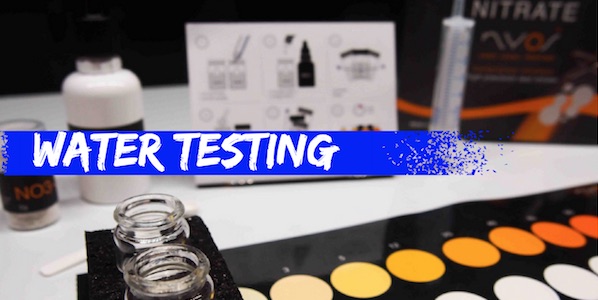It’s crucial to keep tabs on several key aspects of water chemistry if you want to succeed with a saltwater aquarium. That means you’ll have to develop the habit of testing certain parameters on a routine basis. But that doesn’t mean you need to have a background in chemistry or a laboratory at your disposal—just a little time, the ability to follow simple instructions, and the appropriate test kits.
What parameters should I test?
Testing salinity/specific gravity is covered in our “Step-by-Step Guide to Mixing Saltwater,” so we won’t get into that here, but that’s only one of the parameters you’ll need to monitor. For a basic fish-only system, you should also be checking the levels of ammonia, nitrite, nitrate, pH, and alkalinity. (Reef systems demand additional testing, which will be covered in a future post.)
How are water tests performed?
For measuring each of these parameters, there are quality, moderately priced test kits on the market that simply require the addition of one or more liquid or dry chemical reagents to samples of aquarium water (either in a single step or multiple steps). The chemical reagents cause the water to change color, and you can then determine the level of the compound being tested by comparing the water sample to a corresponding colorimetric chart.
For measuring pH, you also have the (potentially more expensive but often more accurate) option of using an electronic digital meter. Some of these devices consist of a separate meter and probe connected by a wire while others incorporate both elements in a pen-like design.
Why test your water?
So let’s look a bit closer at each of these water-chemistry parameters to understand why we need to test for them:
Ammonia
Ammonia is produced through the decomposition of organic matter in the tank—uneaten food, fish poop, dead specimens, etc.—as well as the respiration of fish. Ammonia is deadly to marine livestock, even in small concentrations. In a cycled aquarium, beneficial nitrifying bacteria immediately convert ammonia to less harmful compounds. The desired level of ammonia in any aquarium containing livestock is 0 ppm.
The presence of ammonia in your system indicates one of several possibilities:
- The tank was never cycled to establish biological filtration before livestock was added.
- The biological filter was established but has been disrupted or compromised in some way.
- The bioload has increased to the point that the biological filter can no longer keep pace with the level of dissolved pollutants.
Nitrite
Nitrite is the first byproduct produced when nitrifying bacteria go to work on ammonia. It too is deadly to marine livestock, but slightly less so than ammonia. Its presence also indicates that the cycle has not been fully established or that the biofilter has been compromised or overwhelmed. As with ammonia, the appropriate level is 0 ppm.
Nitrate
Nitrate, which is produced when a second type of nitrifying bacteria goes into action and converts nitrite, is fairly well tolerated by marine fish in lower concentrations. For fish-only systems, the nitrate level should not be allowed to exceed 20 ppm. Corals and other sessile invertebrates are much more sensitive to nitrate, so the goal for reef systems is to keep the level of this compound as close to 0 as possible. Regular partial water changes are the most reliable method of keeping nitrate in check.
pH
The pH of your system’s water is a measure of its hydrogen ion concentration, using a logarithmic scale ranging from 0 to 14. On the pH scale, 7 is neutral, higher readings are more basic (sometimes referred to as more “alkaline”), and lower readings are more acidic. The appropriate pH range for marine livestock is between 8.2 and 8.4.
A slight nighttime drop in pH is normal in aquarium systems, so to get the most accurate results, be sure to test this parameter at the same time every day.
Alkalinity
Though the term “alkaline” is sometimes used interchangeably with “basic” when discussing pH, it actually has a different meaning. Alkalinity refers to the ability of aquarium water to resist a downward trend in pH when an acid is introduced.—another way of saying “buffering capacity.”
You can actually have water that has a relatively high pH but low alkalinity, which means the pH is unstable and prone to dropping below the desired range quickly when an acid is present.
Alkalinity test kits measure carbonates and bicarbonates, which function as pH buffers, so you’ll also see alkalinity described as “carbonate hardness.” The desired alkalinity level for marine systems is beween 8 and 12 dKH.
How often should you test?
If water chemistry begins to drift off course, it’s vital to catch and rectify the problem as quickly as possible, so we recommend testing each of these parameters about once a week—especially if you’re new to the hobby and haven’t yet developed a feel for what’s normal. Of course, more frequent testing is warranted whenever you’re cycling a new aquarium or any time you notice a problem developing.
Also, be aware that test kits do tend to lose efficacy over time. If you start to get odd readings, the first thing you should check is the expiration date on the product. To ensure the highest level of accuracy from an electronic pH monitor, be sure to clean and calibrate it as recommended by the manufacturer.




Does sea water stored in plastic water containers get contaminated. Can a week or 10 days old natural sea water in containers be used for marine aquariums.
Thanks for your question, Abi! As long as the plastic container never held or was cleaned with any potentially toxic or otherwise harmful materials, it should be safe to hold sea water, and you can definitely store the water for a week to 10 days before use with no problems.
Here is a link to a post on collecting natural sea water that you might find helpful:
http://www.saltwatersmarts.com/challenges-of-collecting-natural-sea-water-for-marine-aquarium-2751/